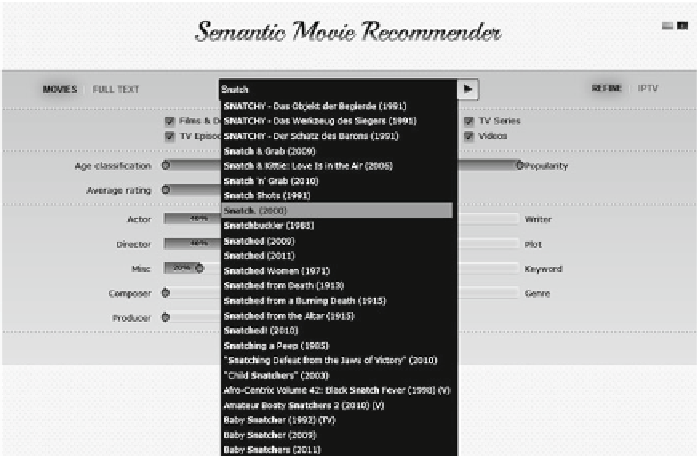Information Technology Reference
In-Depth Information
Fig. 5.5
The figure shows the
auto-completion
function suggesting the user entities matching the
user string input. This avoids problems with ambiguous queries and allows the system to compute
recommendations directly on the semantic graph
Authors
,
Genres
,
Keywords
, and
Plot Descriptions
. The recommen-
dations computed based on the different semantic relationship sets are combined into
one
mixed
list. The combination takes into account individual user preferences by
giving a higher weight to recommender agents that provided recommendations the
user liked in the past.
Browsing the results
: Our recommender system computes relevant movies based
several semantic relationship sets and combines the results in one list. Thus, on
the first view the user finds a list of recommended entities aggregated according
to the individual preferences. Due to the fact, that most of the suggested entities
might unknown to the user, the system provides for each recommended movie a
trailer (a YouTube video), a movie description (retrieved from Freebase), and a
detailed list of actors, directors, producers (retrieved from IMDb). In addition, the
system provides an explanation, visualizing how the recommended movie is related
to the user query (or user profile entries). Figure
5.6
shows a screenshot of our web
application illustrating the generated explanations.
Advanced users interested in the details might browse the recommendations from
each recommender agent (
semantic relationship
) in detail. This feature allows the
user to get different points of view on the recommendations. Users can adapt the
weights for the different recommender agents (controlling the influence of each rec-
ommender agent on the mixture) and explore how new weights change the sugges-
tions. In addition, users can define detailed filter options, such as movie popularity,
average movie rating and age rating. In our evaluation, the popularity filter has been

Search WWH ::

Custom Search